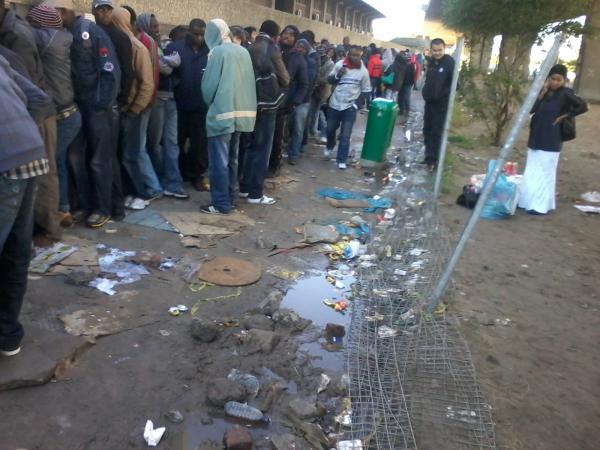Home Affairs uses “sad and bad” court ruling against refugees

The hopes of thousands of asylum seekers in the Western Cape have been dashed by Director General (DG) of Home Affairs (DHA) Mkuseli Apleni.
In a memorandum dated 31 January 2014, the DG states the department will not reopen the Cape Town Refugee Reception Office (CTRRO), which was the second busiest in the country, nor will it process any applications made after 30 June 2012 at the Cape Town Temporary Refugee Facility at Customs House on the Foreshore.
This means that all asylum seekers who had not applied prior to 30 June 2012 or were in the Western Cape after that date must now go to Pretoria, Durban or Musina.
Such journeys place already vulnerable asylum seekers in serious jeopardy and prejudices their livelihoods. As GroundUp has previously reported, en route refugees are sometimes arrested and detained, even deported. Asylum seekers typically have to renew their papers every three to six months.
Apleni said he will give reasons for his decision by 7 February. He says the decision comes “after due and careful consideration of both written and oral submissions of the Refugee Stakeholders, as well as the submissions made by SCRA (the Standing Committee for Refugee Affairs)”.
A “consultation” with stakeholders held on 5 December 2013 appears now to have been mere window-dressing. According to a source present, it “took two hours with no subsequent engagement of any kind despite several requests during it for further information.” Minutes of the meeting show it opened at 10:15am and closed at 1pm and included a tea break. Each organisation was given 15 minutes to summarise their written submissions.
The DG’s decision comes despite two related judgments by the Cape High Court, in which first Justice Davis and then Justice Rogers concurred with the applicant, the Scalabrini Centre, that the closures were irrational and ordered the DHA to process applications by asylum seekers in Cape Town.
Rogers’ order was then upheld on appeal, with costs, at the Supreme Court of Appeal (SCA). But the SCA judgment changed Rogers’ order slightly and provided enough wiggle room for the DHA to directly contradict the Cape High Court order.
A lawyer who did not wish to be identified told GroundUp, “The SCA should be excoriated for their appalling judgment on remedy.”
The SCA had pointed out that to come to a rational decision about the closure of offices, the DG had to consult and obtain the views of organisations representing the interests of asylum seekers.
Those views, duly obtained, were unambiguously against the closure of the Cape Town offices to new applicants, but the DG has gone ahead with the original decision despite these submissions.
Bernard Toyambu, who heads para-legal services at PASSOP (People Against Suffering Oppression and Poverty), which does extensive work in the South African immigrant community, says the SCA decision to give the DHA “the last word” is “very sad and very bad”.
“What will happen to them?” he asks, referring to the numerous asylum seekers in the Western Cape. “They don’t have jobs, they don’t have money to travel to Musina? … How can they just be left in these circumstances?”
Apleni’s decision will cause unnecessary hardship for thousands of people.
Understanding the asylum process
By GroundUp Editor
When refugees arrive in South Africa they have to apply for asylum at a DHA refugee centre. In most cases they will receive a Section 22 permit, also known as an asylum seeker permit. This permit means that a refugee’s application for asylum is being considered. In practice it takes years —sometimes more than a decade— for most asylum applications to be considered. Nevertheless, the Section 22 permit has to be renewed every few months. It is hard to renew the permit anywhere other than where it was originally granted.
The implication of the DG’s decision is that it is almost impossible for new refugees who wish to be lawful to live in Cape Town. To do so they would have to apply for the Section 22 permit up north and have to travel their every few months, which is time-consuming, uncertain and unaffordable.
Even for those asylum seekers who will continue to be processed in Cape Town, the conditions of the temporary refugee centre on the foreshore are disgraceful. Applicants have to wait in long queues from early in the morning. If they are too far back in the queue they will often not be seen and then have to come back another day. To see how horribly people are treated, read Home Affairs violates court order - man arrested despite effort to be lawful and Chaos at Home Affairs foreshore building.
No wonder human rights groups have compared the DHA’s policies to the Group Areas Act under apartheid.
Here is a photo of the queue at the temporary foreshore centre:

In other cities, the DHA has also made it increasingly difficult for asylum seekers. For example, in Port Elizabeth in 2009 businesses and residents near a refugee processing centre successfully asked a court to address the nuisance the centre had become. The DHA failed to do so but instead closed the centre in 2011. The Somali Association of South Africa went to the Eastern Cape High Court to oppose the closure. In February 2012 Justice Pickering ordered the DHA to “open and maintain a fully functional Refugee Reception Office.”
Throughout the country, the DHA appears intent on making life inconvenient and miserable for refugees.
Support independent journalism
Donate using Payfast

Don't miss out on the latest news
We respect your privacy, and promise we won't spam you.

This article is licensed under a Creative Commons Attribution-NoDerivatives 4.0 International License.
